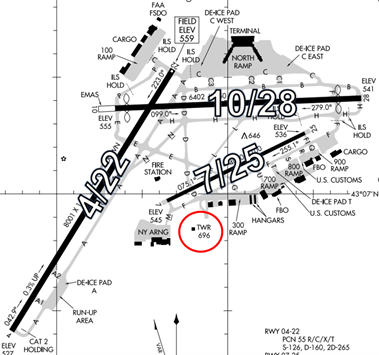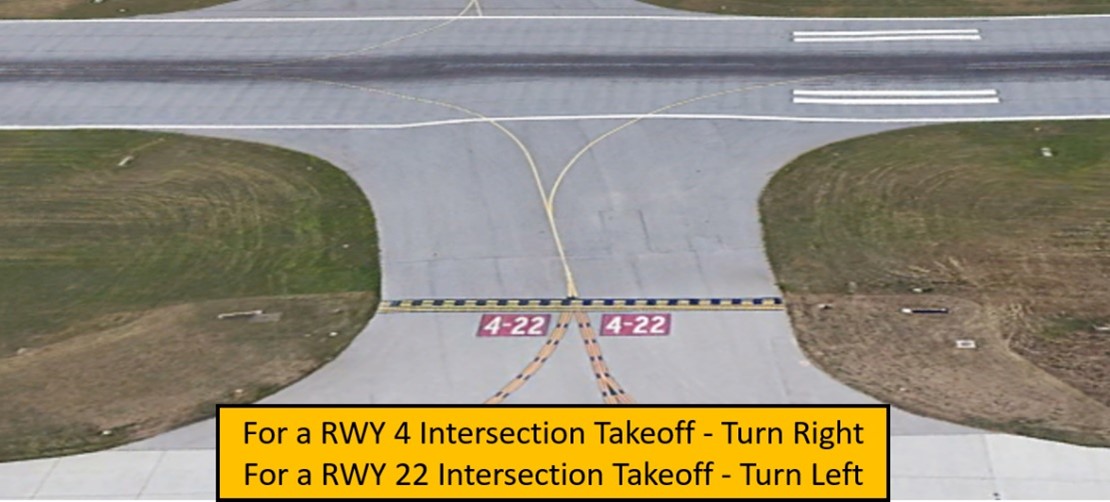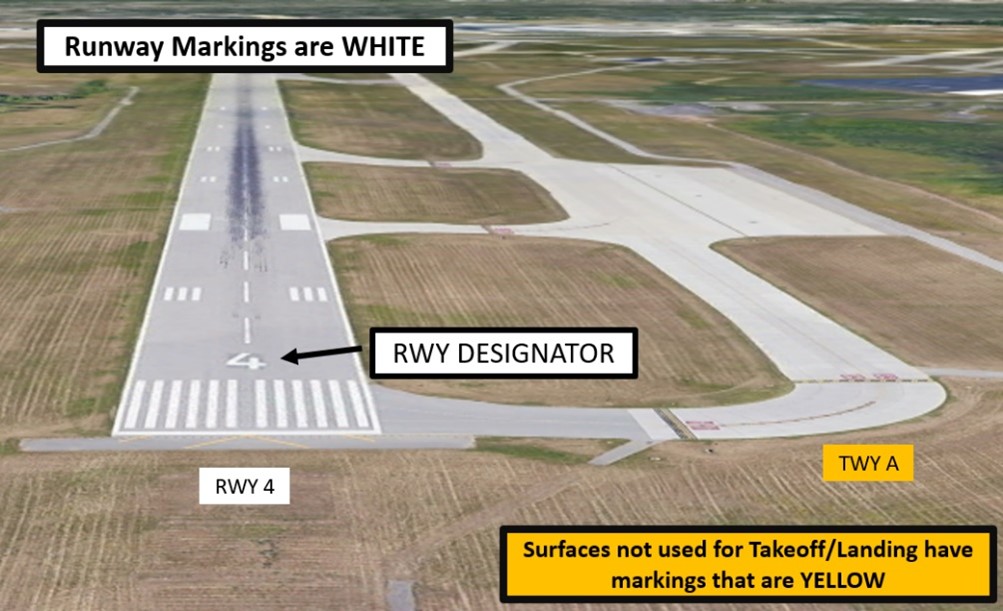Frederick Douglass/Greater Rochester International Airport (ROC)
Frederick Douglass/Greater Rochester International Airport (ROC), located at the southwestern edge of the city of Rochester, NY., supports general aviation, corporate, cargo, military, commercial, and flight training operations. ROC is home to the 642nd Aviation Support Battalion of the NY Army National Guard. This unit flies H-60 Black Hawk and CH-47 Chinook helicopters. View a printable Pilot Handbook of the ROC information found on this Web page.
Know Before You Go
- There are three RWYs. (See illustration to the right.) RWY 10/28 and RWY 4/22 intersect at the northwestern part of the airport. There is a third runway, RWY 7/25 that is much narrower and shorter.
- The air traffic control tower is located just south of RWY 7/25
- Each RWY has a full-length parallel TWY which increases the risk for a Wrong Surface Takeoff or Landing.
- A complex TWY system connects the RWYs to all commercial and military facilities.
The airspace at ROC is Class C. (See Sectional Chart.)
ROC Tower Hours of Operation – Continuous – 24/7.
Administrative Office Open 0700L to 1500L - M through F
Business Phone 585-463-3800
Below find various ROC-specific information and things to be aware of, as well as general information to inform your preflight planning. This will be reviewed quarterly and updated as needed. This information is to supplement the From the Flight Deck Videos that are produced by the FAA Runway Safety Group. Here you will also find information provided by the local air traffic controllers at the airport where you intend to fly. The information is subject to change. Not for navigation or legal* pre-flight action. Always refer to official pre-flight materials such as, but not limited to, NOTAMs, airport diagrams, VFR charts and airport construction notices for the latest airport-specific details.
Hot Spots
- There are no Hot Spots at ROC.
Wrong Surface Intersection Takeoff
- At ROC, intersection departures are authorized. It is critical to verify correct RWY line-up to avoid a potential conflict with landing aircraft.

- Prior to entering the RWY and again when lining up on the RWY, check your Magnetic Compass and, (if installed), your Horizontal Situation Indicator (HSI) to verify that you are pointed in the correct direction.
Wrong Surface RWY Landing See Arrival Alert Notices
- Pilots sometimes confuse RWY 25 for RWY 28.
- RWY 25 and RWY 28 thresholds in close proximity to each other.
Wrong Surface TWY Landing
- A risk exits for pilots to land on a TWY whenever a TWY runs full-length to a RWY.
- At ROC, TWY A runs full-length and parallel to adjacent RWY 4/22.

Additional Information
- Engineered Materials Arresting System (EMAS) located at departure end of RWY 28.
- No practice approaches or maintenance engine runups between 2300-0600.
- Multiple unshielded lights in final approach area for RWY 28.
- Birds, deer, and coyote on and in vicinity of the airport.
- 80’ obstruction – lighted tower west of RWY 4/22 centerline and south of RWY 28 extended centerline.
General
- ROC is a multi-use airport that has a diverse mixture of aircraft. Expect to be intermixed with aircraft of varying performance characteristics.
Traffic Patterns
- A traffic pattern entry is typically issued by approach control prior to transferring communications to TWR. If unsure how to enter, please confirm with TWR on initial contact.
- Expect adjustments to traffic patterns when remaining in closed traffic due to complex RWY configurations.
Ground Control
- When exiting General Aviation Ramps (300,700,800, and 900) to an assigned RWY, use caution for a service road that runs parallel to TWY F. The service road (meant for vehicles only) is located south of TWY F.
- Ground Control does not always specify which TWY to utilize when entering and exiting ramps. When omitted, it is left up to the pilots discretion on which TWY (Q,R,S,T,U or G) to use to enter/exit the G.A. ramps.
Takeoff/Departure
- VFR departures should note that though the standard initial instruction from Clearance Delivery will be to “Fly RWY Heading”, it is not uncommon for TWR to issue a turn with takeoff clearance.
Arrival/Landing
- RWY 25 and RWY 28 thresholds are near one another.
- Pattern traffic told to “continue” shall fly a normal pattern unless specified by TWR.
Weather
- Use caution for un-forecasted lake effect snow bands and squalls during winter months. Visibility can drop extremely rapidly.
Avoidance Areas
- Aircraft conducting air work should avoid loitering in the vicinity of FEPUG (initial approach fix for the ILS RWY 4 approach).
Special Traffic (Military / Commercial / Helicopter, etc.)
- Army helicopters (H60’s and CH64’s) often conduct hover checks midfield near TWY L and can produce significant rotor wash.
